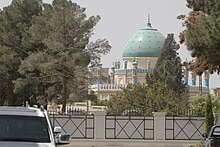Cloak of Muhammad
31°37′11″N 65°42′29″E / 31.6196°N 65.7080°E

The Cloak of Muhammad (Kherqa) is a relic hidden inside Khirqa Sharif in Kandahar, Afghanistan. It is a cloak believed to have been worn by the Islamic prophet Muhammad during the Night Journey in 621 AD.[1]
The cloak itself is locked away inside the mosque and is rarely seen. It has been guarded by the same family for over 250 years.Tomb of Ahmad Shah Durrani is located adjacent to the Shrine of the Cloak.
History
The cloak was given to
stela of stone firmly planted in the ground, saying that he would never take the cloak far from the stone. The keepers, gratified at his answer, handed him the cloak. Ahmad Shah then took the cloak, ordered the stone slab to be dug up, and carried them both back with him to Kandahar, where the stone now stands near his mazar (tomb).[1]
In 1996, Mullah
King of Afghanistan, who twice opened the chest in which the cloak was kept but proceeded no further. The second person was Pir Ahmed Gailani, a political leader and one of Zahir's relatives.[8] In 2012, Waheed Muzhda, an Afghan political analyst and one-time high-ranking official in the Taliban foreign ministry, corroborated that Omar held the cloak but denied a claim that he donned the cloak: "From what I know, from sources close to Omar, and from a chat with the keeper of the shrine [where the cloak is kept], Omar did not wear the cloak. With great respect, he held the cloak in front of the religious leaders gathered for allegiance."[9]
In June 2018, the cloak was last seen in public when Afghan President Ashraf Ghani opened the box of the cloak, and with attendees prayed for peace during a three-day Eid ceasefire in Afghanistan (from 15 to 17 June 2018).[10]
References
- ^ a b c Steve Inskeep (10 January 2002). "The Cloak of the Prophet". npr.org. Archived from the original on 18 January 2002. Retrieved 12 June 2008.
- ^ a b Kevin Sieff (29 December 2012). "A fight for Afghanistan's most famous artifact". The Washington Post. Archived from the original on 16 October 2017. Retrieved 30 December 2012.
- ^ "Aḥmad Shah Durrānī". Encyclopædia Britannica Online Version. 2010. Archived from the original on 4 April 2014. Retrieved 25 August 2010.
- ^ "Ahmad Shah and the Durrani Empire". Library of Congress Country Studies on Afghanistan. 1997. Archived from the original on 31 October 2004. Retrieved 23 September 2010.
- ^ Friedrich Engels (1857). "Afghanistan". The New American Cyclopaedia, Vol. I. Archived from the original on 18 October 2010.
- ISBN 978-1-85109-402-8. Archivedfrom the original on 28 December 2020. Retrieved 23 September 2010.
- ^ a b Edward Girardet; Jonathan Walter, eds. (1998). Afghanistan. Geneva: CROSSLINES Communications, Ltd. p. 291.
- ^ a b c Norimitsu Onishi (19 December 2001). "A Tale of the Mullah and Muhammad's Amazing Cloak". The New York Times. Archived from the original on 28 December 2020. Retrieved 2 May 2020.
- ^ Mujib Mashal (6 June 2012). "The myth of Mullah Omar". aljazeera.com. Archived from the original on 28 December 2020. Retrieved 2 May 2020.
- ^ Shams Rahmanzai (12 June 2018). "President Ashraf Ghani, opens the sacred cloak related to the Prophet of Islam in the nook of ceasefire". rohi.af. Archived from the original on 29 May 2020. Retrieved 2 May 2020.
